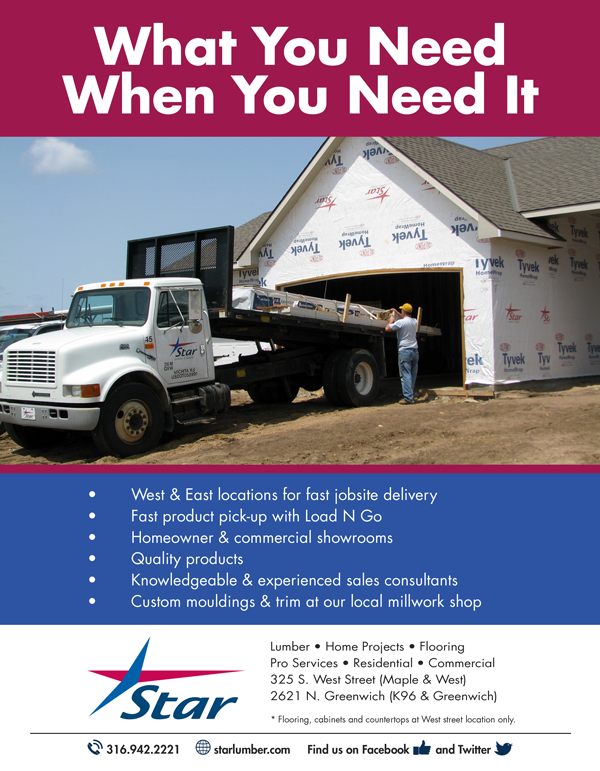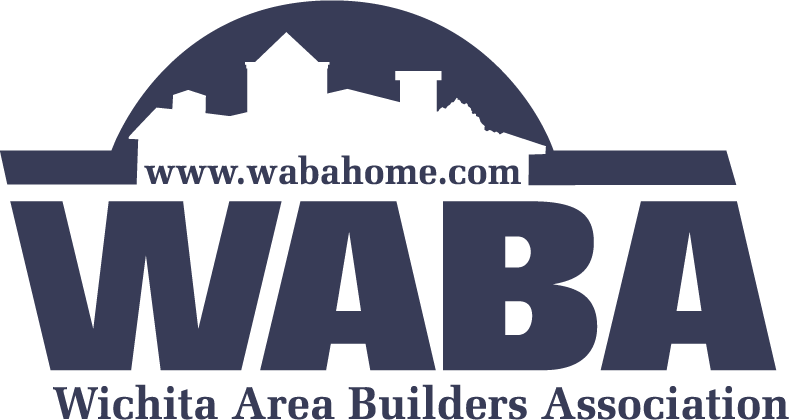





The Cornerstone Club members are a highly visible and an elite group of contributors to the building industry. They are responsible for sustaining a number of Wichita Area Builders Association events and activities over the years to include: special legislative meetings with Key Legislators, social hours at general membership meetings, hospitality rooms at the International Builders Show, hosting Christmas open house, new member orientation mixers, hosting dinners for NAHB staff and officers when they visit our local association, Habitat for Humanity and Homes for Our Troops ribbon cutting events.
In 1979, the leadership of the Wichita Area Builder’s Association wanted to pay special tribute honoring Si Womer, a founder and truly esteemed leader of our Association. The Cornerstone award was created to honor Si and the presentation ceremony was probably the most memorable event I have experienced as a member since that time. Also, near that same time we decided that it wasn’t fair to continually ask a very small group of large companies to sponsor our social and political events. Clearly it was time for the rest of us to help sponsor some of these events but in a much smaller, more affordable way. Although the original award was intended to be a one-time event, the idea caught on. The opportunity for recognizing a true “Cornerstone” of the industry and the financial opportunity for service from additional members led to the birth of the Cornerstone Club.
By their active involvement in all three phases of membership beginning at the local level in the Wichita Area Builders Association, on the state level with their participation in the Kansas Building Industry Association and at national level by their committee work in the National Association of Home Builders, Cornerstone award recipients strive to “make a difference” at each level of involvement for the betterment of the entire building industry.
This year, the Cornerstone Award Committee, consisting of the last three Cornerstone Award recipients, Jim Gearhart, David Gatz and Tom Baalmann, made the decision it was past time that we recognize Wess Galyon for all his contributions to our industry.
During the annual Cornerstone Banquet, it was announced that Wess Galyon will be this year’s Cornerstone Award recipient and was recognized for making outstanding contributions to the Association and the industry over his thirty plus years serving as our President/CEO of WABA. Through his leadership and mentoring process, he has developed one of the top builders’ associations in the country here in Wichita. To the Cornerstone Club members, he is more than a paid staff member, he is a “builder.” He does not use 2×4’s and nails as we do to build a house, because he uses alliances and collaboration to bring us together in the association to achieve more than we could ever achieve on our own.
Under his leadership we built a new Office for our staff, when it became evident, we needed a new “home” and Wess was our builder of choice. Wess lead us into founding the Home Builders Care Foundation to leverage our collective efforts to help all the philanthropic causes we are partners with such as, Habitat for Humanity, Victory in the Valley, Inter Faith Ministries, Wichita Children’s Home, Homes for Our Troops, Make-A-Wish and the Kansas Food Bank to name a few.
Wess has been our voice to the elected officials when it comes to anything that effects our industry politically. The association desires, “to be seated at the table rather than being on the menu,” when dealing in the political realm of our business. In this arena Wess has served on several selection committees to hire city and county staff that affect the building industry. He oversaw the consolidation of the building codes inspection department from the city of Wichita and Sedgwick county into one government agency known today as Metropolitan Area Building Codes Department.
Wess was instrumental in getting our product, a newly constructed home, into the hands of every buyer with our web presence, “ahouseahead.com.” The leadership he provided in building this website allows all members the opportunity to market their newly constructed home in a unique way on the internet. “Ahouseahead.com” only markets newly constructed homes and differentiates them from all the resale homes on the internet by bringing everything “new” together in one location on the web.
Wess has accomplished many things as our Association’s CEO and has been “making a difference” in our industry since 1986. We felt it was time to honor him for all his contributions. The award will be presented to Wess at the Home Show VIP night in February. We hope you’ll join us that evening in honoring him.
Congratulations Wess Galyon 2019 Cornerstone Recipient.







The holidays are fast approaching as we move toward the end of the current year and look optimistically forward to the challenges and opportunities that will come our way in 2020. To be sure, we are hopeful things will go better for all of us as we continue to work our way through and out of a what remains somewhat of a flat, but stable, market in our area in terms of the number of new homes constructed and sales made annually the last five years. With positive things happening such as the elimination of job killing government regulations, especially at federal level; stabilizing costs of materials; continuing near record low interest rates; and what appears to be gradual but still growing confidence in the overall economy, we have much to be thankful for.
Given what we know about our market conditions locally, I thought it would be beneficial if all members of our Association had access to the content of a recent interview conducted with NAHB Chief Economist Robert Dietz wherein, he talks “growth recession” and housing in 2020. The totality of the questions posed and Dietz responses to them are below:
NAHB Economist Robert Dietz Talks ‘Growth Recession’ and Housing in 2020
Q&A with the National Association of Home Builders’ chief economist to answer some of the industry’s burning questions about the housing market and economic forecast.
By Mike Beirne, Senior Editor | October 22, 2019
What inning is it in the economic cycle? Will the next recession be a mild one? These are the questions inevitably asked whenever home builders get together and an industry economist like Robert Dietz is on stage.
Dietz worked as an economist for the Congressional Joint Committee on Taxation before joining NAHB in 2005, where he currently leads a group of 12 economists producing housing forecasts and analysis across several housing metrics.
We asked him some of the burning questions home builders currently have, like where the economy is headed, the impact of mortgage interest rates on sales, and what are the supply-side concerns housing policy makers should heed.
Q What’s your current forecast for the U.S. economy, and does it involve a recession?
A Our forecast window goes through the end of 2021, and we don’t have a full-blown recession on our forecast tables right now.
We’ve had a fairly consistent macro forecast for at least two years. We thought 2018 was going to be a fairly strong year because the average GDP growth was 3.4% [in 2017]. But it came in a little under that growth rate, at 2.9%, and we think that was due to the effects of international trade. This year we’re saying it will slow to about a 2.3% growth rate, and then we have it slowing more still in 2020 and 2021, with both of those years having growth rates between 1% and 2%. In fact, in 2021 we predict a 1.5% growth rate. Some economists would call that a “growth recession.”
In a growth recession, you can have the occasional weak quarter. The unemployment rate begins to tick up. It will still be fairly low, but we don’t think it will be below 4%, which means we’ll have some soft job-market reports.
Q What’s causing—or will cause—GDP and job growth to slow?
A We think some macro risk factors will be responsible for the slowing. Some of them are already baked into the cake. For example, the reason 2018 had relatively solid growth was because of tax reform and tax cuts, which induced a fair amount of business investment.
That stimulus effect is over, so now we have drags, such as the ongoing trade wars, which are having an impact on manufacturing and the agricultural sectors, as well as clear local housing market impacts from the weakness in those two sectors.
Another macro factor is the labor market remaining tight. It’s one of those good news/bad news situations. The unemployment rate is 3.7%, which is fantastic. It’s good for rental housing demand, it’s good for for-sale housing demand. But it can be tough to fill construction industry jobs when productivity growth [GDP] isn’t strong enough and you don’t have wage growth sufficient to lift labor force participation, which means you don’t have an available pool of workers, and therefore, you get slowing job creation.
Q You mentioned trade policies affecting local housing markets. How so?
A As a result of recent trade policies, agriculture has declined for the last two years. Corn and soybean prices are down 50% year over year. Exports have gone down. All of that has reduced housing demand and economic activity in some agricultural areas.
With manufacturing we have some detail analysis. We do something called the Home Building Geography Index [HBGI], which we use to track local market conditions. We don’t do it by metros because a fair number of people do that. What we do is track regional conditions. For example, we found that if you compare large metro suburbs with the exurbs, in the last year the exburbs have been growing faster.
Our forecast window goes through the end of 2021, and we don’t have a full-blown recession on our forecast tables right now.
But another cut that we did with this index was to look at areas where a large share of employment is attributable to manufacturing. As manufacturing softened, what we noticed is that single-family construction in those manufacturing areas also declined.
We found that in the second quarter last year, single-family permits in manufacturing areas were down just under 4%. So, you have definite housing weakness that tend to be dependent on manufacturing and exporting, and that’s a consequence of the trade fight.
The plan on this index, going forward, is to update all of those prior regional differences, and in the next quarter, we’ll introduce a new one. So, we’re talking among ourselves now. If it’s third quarter, are we going to do agricultural areas? College towns or areas with a lot of townhouses? There are a lot of different options; the idea being that everybody can come up with a top 10 list of something. We want to stay away from those.
I like this regional thing because it connects the macro elements that we’re talking about to where builders are building. By the way, when we looked at the rest of the country, non-manufacturing areas were down, but they were only down a little bit, so a lot of the recent weakness in single-family construction is concentrated in manufacturing areas.
Q What about inflation and interest rates? What do you expect from the Fed?
A So you have trade conflict, slowing job creation, and then we still have to be on the watch for any inflationary pressures, even though inflation has been missing in this current cycle. For that reason, the Federal Reserve raising the fund rate by 100 basis points in 2018 was too aggressive. There was just not the amount of inflation to require that policy position.
The Fed’s job is to maintain maximum employment and prevent inflation, so it’s going to be vigilant. That may mean that while the Fed has definitely moved into a dovish posture—it cut rates in September and we think it’s going to cut rates again, perhaps twice more after that—but it may offer a smaller number of rate cuts than Wall Street expects.
Q This recovery started with builders targeting buyers of upscale, luxury homes, while attention to building entry-level product, which has typically kicked off past recoveries, came later. After a growth recession, would we see upscale building picking up first again?
A No. When we look at inventories right now, there’s not a lot of growth potential for that higher-end market, which was the easiest for builders to build to. I say “easiest” with some reservation, as there is no market in building that is “easy.” But in the—let’s call it the custom market—with larger, higher priced homes, there is a lot more resale inventory there. That share of the market has been about 20% of housing starts. I expect that market to hold flat.
Where we do expect to see growth is in the entry level [homes] market. It’s just starting to come in fits and starts and has been sluggish. It’s kind of been two steps forward, three steps back on entry level, and, if anything, in the last year, it was more like three steps forward and three steps back. What we saw in the geography index is that the places where there was a lot of potential for entry-level market expansion were those areas where there was either higher density, single-family detached—so, smaller homes—or townhouse construction.
Where we do expect to see growth is in the entry level [homes] market. It’s just starting to come in fits and starts …
Now, if you think about where townhouse construction occurs, there are good examples in the large metro areas, where you have townhouse construction in the exurbs near mass transit. But in a lot of cases, that kind of higher density—single-family attached, single-family detached—is occurring in the inner suburbs. When we looked at the geography index, what we found was that those large metro suburbs really slowed down the most due to the housing affordability crunch at the end of 2018 and into the first part of this year.
That’s the three steps forward, three steps back. A lot of builders were getting into entry level, but they pulled back at the start of 2019. Now that interest rates are lower—to the extent that builders’ financing channels are open—I think we’re going to see expansion at that lower end for the remainder of this part of the cycle.
So, in the high-end market, there’s not a lot of growth potential, but it’s relatively stable, partly because a significant share of older buyers are large cash or large down-payment buyers. There’s more growth potential at the entry level, but also more volatility.
As a result, some quarters may be stronger, where we see the expansion of that kind of product, and other quarters—because of those buyers seeking out entry-level homes—are going to be more sensitive to changes in housing affordability conditions. We saw that in the fall of 2018 when mortgage rates got to 5%. That high loaned-value mortgage buyer, that prospective first-time buyer who doesn’t have a large payment, they’re going to be very sensitive to those kinds of interest rates and down payment requirements.
Q Mortgage interest rates rose during 2017 and, for some house shoppers, may have created a sense of urgency to buy. What impact, at this point of the economic cycle, might declining/stable low mortgage rates have or not have on buyers and on builder confidence?
A Buyer prospects are relatively cautious. If you look at the consumer confidence measures, they’re a little off their highs, but they’re near 20-year lows, so we’re in a pretty good position, even if they’ve been reduced this year because of the stock market decline at the end of 2018 and the partial government shutdown.
But the other thing to keep in mind is that for a first-time homebuyer, they have to have the down payment to be able to benefit from the low interest rate. I think that is a challenge because, as home prices and construction costs continue to rise faster than income growth, that down payment requirement has become increasingly out of reach for a growing number of first-time buyers. Sometimes when we focus on the rates, we’re missing the ability to translate the potential demand into somebody who can claim it.
In addition—and this has been my thing for the last four or five years—we can’t forget the supply side. Something like 75% of builders are not high production, national home builders that get financing through Wall Street. They’re small and regional builders that get their financing through banks, particularly community banks. When we do our quarterly surveys of the financing conditions for acquisition development construction loans [AD&C], interest rates from mortgages went up last fall and then came down. But when we look at interest rates in AD&C loans, particularly construction loans, they went up last fall and they stayed up. For example, a spec 1-to-4-unit construction loan is right around 6%. It did not come down.
We do our economic builder survey once a year and we still find that two-thirds of home builders are saying lot supplies in their market are low or very low.
So, there are some additional risk factors that are still in place for lending, if you don’t have those lending channels available. And even if you do have some growth and potential demand due to lower mortgage interest rates, it can’t translate into growth for single-family permits unless builders can get financing so they can acquire lots, develop land, and build homes. So, I’m a little concerned about that.
There’s a lot of discussion about what an inverted yield curve means. Of course, it’s part of the stock market technical analysis, but the inverted yield curve is not a sufficient condition for a recession. It doesn’t guarantee that you get one. It’s usually is a sign of an impending slowdown and some kind of recession, say over the next two to three years.
But what it is a warning about is credit conditions in the bond markets. Those markets are telling you that there is some concern about lending conditions. So, if you see an inverted yield curve and follow that up with some data about the tightening of credit conditions—in other words, the flows of lending begin to decline—that then is a sufficient condition for recession.
So far, we don’t see that. The September 10 consumer credit report shows that consumer credit grew. But the fact that those AD&C loan rates remain elevated is one part of the credit system that appears to be tighter than it was, and that’s a concern. Whether it’s policy makers or homebuyers or other housing stake holders, if they’re worried about housing affordability and the relative availability of inventory, they need to be looking at some of these variables within the home building supply side of the market that says we’re not really going to get this huge growth in inventory to take advantage of these lower rates.
Q Does the inability of prospective first-time buyers to amass a down payment put builders who want to expand into the entry-level market in a vulnerable position?
A We know from demographics and economic potential that the growth for the home builder is that entry level market. It’s that first-time buyer … that Millennial who is now in their early 30s and renting who wants to buy a single-family home. There are risks. That’s why I said there is growth potential with higher volatility and, depending on credit market conditions, builders’ financing costs could go up.
During most of this recovery, regulatory costs are higher, and with building material costs in 2018 we saw lumber prices go on a roller-coaster ride. At one point, prices went up 60%, easily adding $8,000 to a typical single-family home. If you think about the risk … the builder needs to repay the lenders, and they’ve got to cover those costs, some of which are highly volatile. As growth cycles age, risk tends to grow, and I think that’s what we are seeing in these bond market conditions. There is this growing risk of additional slow-down, even though if you look at the basic economic variables, things tend to be fairly healthy right now.
Q So, as consumer confidence goes, it doesn’t necessarily mean that builder confidence will follow?
A Yes. We saw the builder confidence index take a big drop last fall, and it’s been recovering since then. It continues to trend up to the level 65, which is positive. In the comments from the survey, what we hear builders say is, “I’m worried about my access to skilled labor. I’m worried about regulatory costs [which includes things like impact fees], and while I have potential buyers, they can’t all call me for a mortgage because of pricing and affordability constraints.”
Q Where does the NAHB stand on whether builders are overleveraged or not with land?
A It really depends on the kind of builder and where they build. There are large metro markets with plenty of lots, but they’re in the wrong locations. Our geography index said that at the start of the year exurban locations were the only places that were growing.
Single-family permits were declining in the outer suburbs, inner suburbs, and core areas. Exurbs were growing because there was some lot availability in those markets.
If you talk to some analysts, they may say that lot supplies are fairly large for this metro area. Well, it depends on where in the metro area. Some of it depends on the kind of builder. Larger builders with deeper pockets are going to have more favorable access to land and lots. We do our economic builder survey once a year and we still find that two-thirds of home builders are saying lot supplies in their market are low or very low. So I would still list lots as being scarce or relatively scarce on a nationwide basis for the typical builder—that builder being a small or regional type builder.
I think a lot of that is due to seeing relatively positive market conditions in front of them, but lots may not be at the prices where builders incorporate them into their business model and can supply homes that meet potential buyers’ budget constraints. Trying to get more efficient zoning rules, trying to fight some of the growth in impact fees, trying to increase the speed at which land development occurs; all those things are factors that could really help with achieving housing affordability.
Q What is NAHB outlook for home price appreciation?
A Some volatility. What we noticed over the last two years is that home price growth has been slowing. Up until that period, home prices have definitely been rising faster than income growth. In a healthy market, home prices should be growing exactly along the lines of income growth. When they’re growing faster, it’s usually a sign of scarcity. When they’re growing faster than income growth, it’s usually a sign of oversupply.
Without a doubt, this market has been characterized by undersupply since we got through the Great Recession because of the lack of home building, so home prices are growing a little faster than incomes. That gap has closed a bit. There is some interesting commentary out from Frank Nothaft, chief economist at CoreLogic, who expects a little bit of re-acceleration [5.4% by July 2020]. I was a little surprised it was that strong because when Frank and I talked about it going into 2017, and thinking about what tax reform would do, we said we didn’t expect tax reform to reduce the home building sector, but we did think it was going to slow home price growth.
This cycle is really about a slowdown. It’s not about a multiyear Great Recession type of environment.
There were other estimates out there that were more dramatic, such as a 10% decline in home prices. We didn’t think we were going to get anything like that, but we did think home price growth was going to slow. It did. I think what they’re looking at—not us—is that lower rates are going to bring some sideline demand in and home price growth. Our forecast is home price growth continuing a bit faster than income growth. Both could end up slowing if we go into something a little more serious than a growth recession.
One of the things I think we can look at with current conditions is for builders to ask: Is today more like 1998, or is it more like the year 2000? In both of those environments, you had concerns about a slowing economy: 1998 was connected to concerns about financial issues with financial investment firms, but the Fed was able to ease those concerns and the growth cycle continued; in 2000, the Fed was easing concerns about an inverted yield curve and then we had a recession in 2001.
I tend to hedge closer to the idea that it’s closer to 1998 than to 2000. The current cycle does have some growth potential, but if we would enter into a recession more like 2000, that would give you a fairly good simulation of what this economy in terms of slowing conditions would look like. It would mean a slowdown in price growth and a slowdown in home building.
This cycle is really about a slowdown. It’s not about a multiyear Great Recession type of environment. It’s quarter to quarter, reviewing your strategic plans. I’ll give you another example that’s consistent with that. Despite the slowdown in home production that we’ve seen since last fall, the size of the residential construction labor force has continued to grow. That is sort of the opposite of what you would expect given that single-family permits are down. You would not expect a lot of growth in home building, but because we had a skilled labor shortage, people still want to get talent into their firms so when growth does return, they’re ready for it.
We’ve had years of under-building. Builders are being cautious about the macro headwinds, but they still see a lot of demographic potential over the next five to 10 years as those Millennials progressively move into their mid-30s and early 40s and really represent a lot of potential home building demand, particularly on the single-family side.


©2020 Wichita Area Builders Association. All rights reserved.
730 N Main | Wichita, KS 67203
{p} 316.265.4226 | {f} 316.265.5964
Site by Wichita Tech Services, LLC | Sitemap